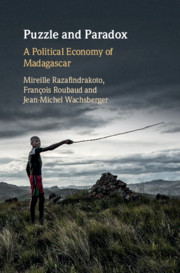Book contents
- Puzzle and Paradox
- Puzzle and Paradox
- Copyright page
- Contents
- Contents
- Tables
- Boxes
- Foreword
- Acknowledgements
- Abbreviations and Acronyms
- General Introduction
- 1 The Malagasy Mystery through the Lens of Economic Growth and Development Theories
- 2 Milestones for a Political Economy of Madagascar’s Trajectory
- 3 Structural Assets
- 4 Obstacles
- 5 Elites in Madagascar: A Sociography
- General Conclusion
- Timeline
- Glossary of Malagasy Terms
- References
- Index
General Introduction
Published online by Cambridge University Press: 12 February 2020
- Puzzle and Paradox
- Puzzle and Paradox
- Copyright page
- Contents
- Contents
- Tables
- Boxes
- Foreword
- Acknowledgements
- Abbreviations and Acronyms
- General Introduction
- 1 The Malagasy Mystery through the Lens of Economic Growth and Development Theories
- 2 Milestones for a Political Economy of Madagascar’s Trajectory
- 3 Structural Assets
- 4 Obstacles
- 5 Elites in Madagascar: A Sociography
- General Conclusion
- Timeline
- Glossary of Malagasy Terms
- References
- Index
Summary
Madagascar is one of the poorest countries in the world today, with gross domestic product (GDP) per capita of less than 400 dollars in 2016 and a colossal rate of monetary poverty (over 90% on the international poverty line). Yet nothing appears to have ever marked the country out for such a terrible fate. Far from it, in fact. Although the latest political crisis that started in early 2009 and found an electoral conclusion in late 2013 has played a role, it is a mere blip on the historical radar. Madagascar’s long-term economic trajectory is a real mystery, which raises farther-reaching questions as to what is behind the divergent development processes observed in the world today. Not only has per capita GDP been trending downward since 1960, but also every time the country has set out on a growth path, it has been stopped in its tracks by a socio-political crisis that has shattered the hopes it raised.
- Type
- Chapter
- Information
- Puzzle and ParadoxA Political Economy of Madagascar, pp. 1 - 6Publisher: Cambridge University PressPrint publication year: 2020



